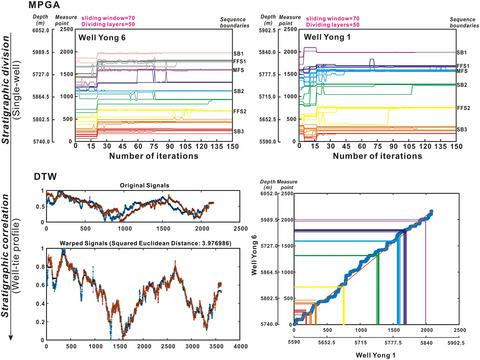当前位置:
X-MOL 学术
›
Basin Res.
›
论文详情
Our official English website, www.x-mol.net, welcomes your
feedback! (Note: you will need to create a separate account there.)
Intelligent identification of sequence stratigraphy constrained by multipopulation genetic algorithm and dynamic time warping technique: A case study of Lower Cretaceous Qingshuihe Formation in hinterland of Junggar Basin (NW China)
Basin Research ( IF 2.8 ) Pub Date : 2021-04-30 , DOI: 10.1111/bre.12567 Bingbing Shi 1 , Xiangchun Chang 1, 2 , Zhongquan Liu 3 , Yumao Pang 1, 2 , Youde Xu 3 , Lixin Mao 4 , Pengfei Zhang 1 , Guo Chen 1
Basin Research ( IF 2.8 ) Pub Date : 2021-04-30 , DOI: 10.1111/bre.12567 Bingbing Shi 1 , Xiangchun Chang 1, 2 , Zhongquan Liu 3 , Yumao Pang 1, 2 , Youde Xu 3 , Lixin Mao 4 , Pengfei Zhang 1 , Guo Chen 1
Affiliation

|
The division and correlation of sequence stratigraphy are one of the essential steps in petroleum exploration. To comprehensively utilize the sequence stratigraphic information implied in multiple wireline well logs and improve the accuracy and reliability of sequence stratigraphic division, based on the edge detection, optimal partition, and natural evolution theories, and realizes the information fusion (formed one ‘chromosome’) of multiple wireline well logs (named as ‘genes’) which can reflect the feature information of sequence stratigraphy by using multipopulation genetic algorithm (MPGA) based on Fisher algorithm, in this study, geophysical data (wireline well logs and 3D seismic data) were used for spectral trend attribute analyses (wavelet transform, maximum entropy spectrum, time-frequency analyses, and integrated prediction error filter). Since the seismic reflection characteristics of K1q were difficult to identify and considering subjective factors in conventional methods, a MPGA was also used to intelligently identify the sequence stratigraphy framework of the Lower Cretaceous Qingshuihe (K1q) Formation. Since the MPGA is an optimization algorithm, the code was run 10 times for accuracy with changes in the dividing layers. The optimal parameters in the process of data fusion (gene combination process) are selected. The sequence boundaries (SBs) searched by the MPGA matched those of the spectral trend attribute analyses, confirming that the MPGA was an effective, fast, and user-friendly tool for defining the main SBs. MPGA can provide an optimal layering scheme (‘elite population’) through simultaneous searching at multiple depth ranges (‘multipopulation’), recording the optimal SBs (‘elite individuals’) of each population and making the results more convinced. Although simulation solutions may not be unique, the MPGA still provides us a chance to gain some insights into the details of the stratigraphy. Based on this intelligent identification, the maximum flooding surface, two first flooding surfaces (FFS), and three SBs were defined in K1q. The cyclic patterns (prograding, aggrading, and retrograding) were identified. They showed the relationship between accommodation space (related to tectonic subsidence of the Chemo paleo-uplift) and sediment supply. In addition, dynamic time warping (DWT) technique was used for sequence discrimination and correlation on the integrated prediction error filter analyses curve. A massive pebbly sandstone set, named ‘bottom sandstone,’ was identified in the lowstand system tract of SQ1 (K1q1), constrained by SB1 and FFS1, which was a favourable hydrocarbon exploration target.
中文翻译:

多种群遗传算法和动态时间扭曲技术约束层序地层智能识别——以准噶尔盆地腹地下白垩统清水河组为例
层序地层划分与对比是油气勘探的关键步骤之一。综合利用多条电缆测井中隐含的层序地层信息,基于边缘检测、最优划分、自然演化理论,提高层序地层划分的准确性和可靠性,实现信息融合(形成一个“染色体”)利用基于Fisher算法的多种群遗传算法(MPGA),对能够反映层序地层特征信息的多条电缆测井(命名为“基因”)进行了地球物理数据(电缆测井和3D地震数据)用于谱趋势属性分析(小波变换、最大熵谱、时频分析、和集成预测误差滤波器)。由于 K 的地震反射特性1 q常规方法难以识别和考虑主观因素,还利用 MPGA 智能识别下白垩统清水河 (K 1 q)层序地层格架) 形成。由于 MPGA 是一种优化算法,代码运行了 10 次以提高分割层的准确性。选择数据融合过程(基因组合过程)中的最佳参数。MPGA 搜索的序列边界 (SB) 与光谱趋势属性分析相匹配,证实 MPGA 是定义主要 SB 的有效、快速且用户友好的工具。MPGA 可以通过在多个深度范围('multipopulation')同时搜索,记录每个种群的最佳 SB('精英个体')并使结果更加可信,从而提供最佳分层方案('精英种群')。尽管模拟解决方案可能不是唯一的,但 MPGA 仍然为我们提供了一个机会来深入了解地层的细节。1 q。确定了循环模式(升级、升级和逆行)。他们展示了容纳空间(与 Chemo 古隆起的构造沉降有关)和沉积物供应之间的关系。此外,动态时间规整 (DWT) 技术用于在集成预测误差滤波器分析曲线上进行序列鉴别和相关。在SQ1(K 1 q 1)低位体系域中发现了一块块状卵石砂岩组,称为“底砂岩” ,受SB1和FFS1约束,是有利的油气勘探目标。
更新日期:2021-04-30
中文翻译:

多种群遗传算法和动态时间扭曲技术约束层序地层智能识别——以准噶尔盆地腹地下白垩统清水河组为例
层序地层划分与对比是油气勘探的关键步骤之一。综合利用多条电缆测井中隐含的层序地层信息,基于边缘检测、最优划分、自然演化理论,提高层序地层划分的准确性和可靠性,实现信息融合(形成一个“染色体”)利用基于Fisher算法的多种群遗传算法(MPGA),对能够反映层序地层特征信息的多条电缆测井(命名为“基因”)进行了地球物理数据(电缆测井和3D地震数据)用于谱趋势属性分析(小波变换、最大熵谱、时频分析、和集成预测误差滤波器)。由于 K 的地震反射特性1 q常规方法难以识别和考虑主观因素,还利用 MPGA 智能识别下白垩统清水河 (K 1 q)层序地层格架) 形成。由于 MPGA 是一种优化算法,代码运行了 10 次以提高分割层的准确性。选择数据融合过程(基因组合过程)中的最佳参数。MPGA 搜索的序列边界 (SB) 与光谱趋势属性分析相匹配,证实 MPGA 是定义主要 SB 的有效、快速且用户友好的工具。MPGA 可以通过在多个深度范围('multipopulation')同时搜索,记录每个种群的最佳 SB('精英个体')并使结果更加可信,从而提供最佳分层方案('精英种群')。尽管模拟解决方案可能不是唯一的,但 MPGA 仍然为我们提供了一个机会来深入了解地层的细节。1 q。确定了循环模式(升级、升级和逆行)。他们展示了容纳空间(与 Chemo 古隆起的构造沉降有关)和沉积物供应之间的关系。此外,动态时间规整 (DWT) 技术用于在集成预测误差滤波器分析曲线上进行序列鉴别和相关。在SQ1(K 1 q 1)低位体系域中发现了一块块状卵石砂岩组,称为“底砂岩” ,受SB1和FFS1约束,是有利的油气勘探目标。











































 京公网安备 11010802027423号
京公网安备 11010802027423号